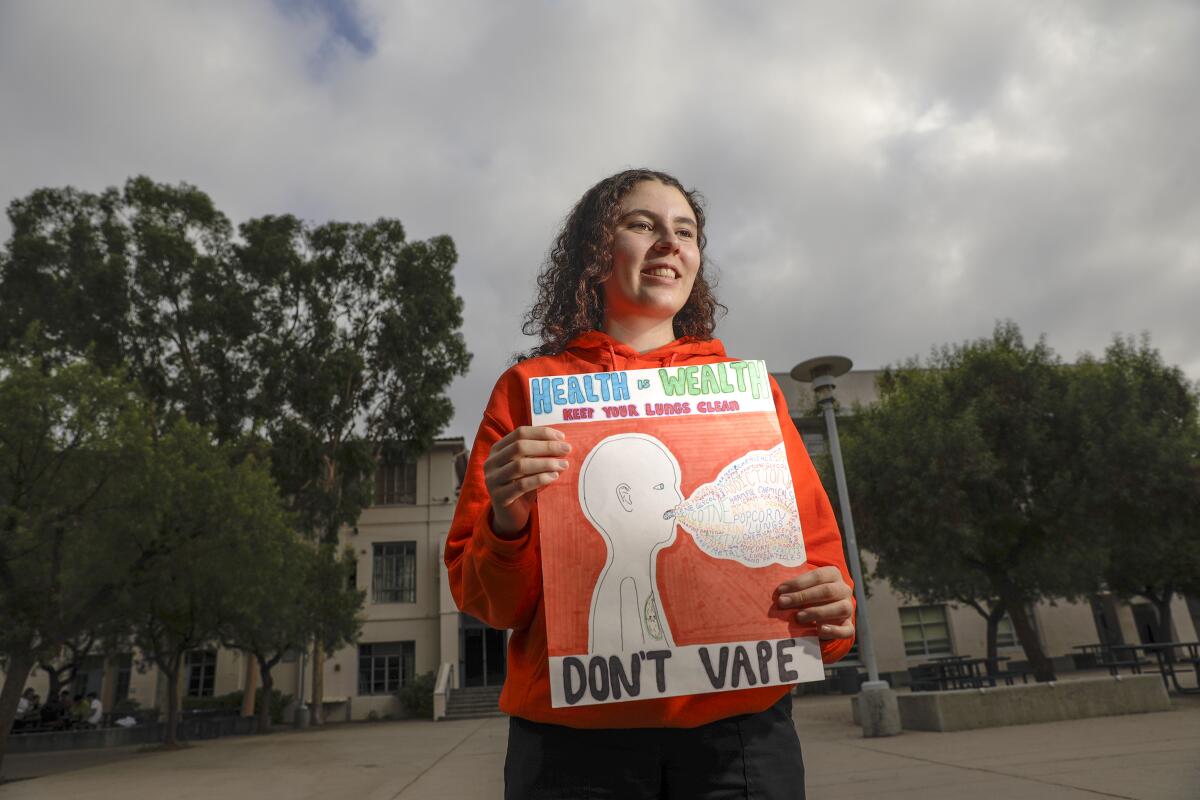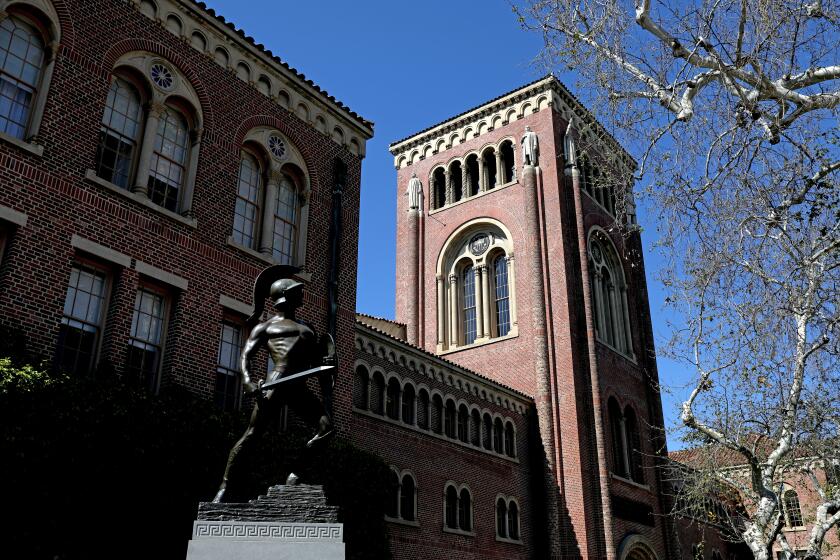Student vaping epidemic has California schools frantically mobilizing

- Share via
Students at Crescenta Valley High School have created an anti-vaping app. At nearby Rosemont Middle School, 55 students have joined an anti-vaping club. Santa Monica schools have booked 20 anti-vaping and drug awareness student assemblies and parent meetings. Staffers at various Southern California campuses are stepping up patrols of hidden nooks, installing costly detection devices, bringing in addiction counselors and modifying health curricula.
The recent surge of lung illnesses and deaths linked to vaping, an increasingly entrenched habit among many youths, largely caught school authorities flat-footed, and educators are urgently mobilizing anti-vaping efforts against what they see as a dangerous teen epidemic.
“We’ve seen this develop very quickly,” said Crescenta Valley Principal Linda Junge. “We’re seeing a public health crisis that has come onto campus.”
Experts foresee long-term problems for a generation of students.
“The use of these products is not only creating a whole new generation of young people who are addicted to nicotine and will spend the rest of their life buying nicotine in one form or another ... it’s reducing all the kind of gains we’ve made during the ’90s and the 2000s getting youth not to take up smoking,” said Dr. James Sargent, a pediatrics professor at the Geisel School of Medicine at Dartmouth.
Rosemont Middle School Principal Scott Anderle recalled confronting an eighth-grader, “a nice kid and a good student,” asking why he was vaping in the classroom. Why couldn’t he even wait for the class to end?
“He looked at me with sad eyes and said, ‘I can’t stop.’”
Almost one-third of Los Angeles County high school students have tried e-cigarettes at some point, and 10% regularly use them, according to the latest data from the 2017-18 California Student Tobacco Survey and the California Healthy Kids Survey. Students and school staff believe youth vaping has only increased since then. It is illegal in California to sell vaping products to anyone younger than 21.
School officials have been concerned about vaping as it caught on in recent years. But their worries were amplified after 805 recent cases of vaping-related lung injuries reported from 46 states and one U.S. territory. Twelve deaths have been confirmed in 10 states, including two in California. In cases documented by the U.S. Centers for Disease Control and Prevention, 38% involve people younger than 21, and 16% involve patients younger than 18.
The school actions come as California health officials last week advised people to stop vaping both nicotine and THC, the psychotropic ingredient in marijuana. In addition, Los Angeles County supervisors have given preliminary approval for a ban on flavored tobacco products, including e-cigarettes, which would apply to unincorporated parts of the county. In Los Angeles, City Atty. Mike Feuer is recommending a similar ban. Other California cities and counties already have taken action, including San Francisco.
Massachusetts and Michigan also put restrictions on e-cigarette products.
Increasingly, schools are enlisting students to move to the front lines of anti-vaping efforts.
The student-designed anti-vaping app at Crescenta Valley High School was commissioned by Associate Principal Christine Benitez. The app allows students to report quickly when they see someone vaping in a bathroom on campus. Benitez said she hopes to use the data to respond to problem locations and times. The names of the students who developed the app are secret because the creators don’t want to become potential targets for classmates who object to their work.
Crescenta Valley junior Lucy Levine is downright public about where she stands as a winner of a PTA-sponsored anti-vaping poster and video contest.
“Health is Wealth,” her poster advises, a saying she borrowed from her grandfather.
The Glendale Unified School District is distributing the winning posters across the school system, the county’s third-largest.
In addition, Glendale is paying $30,000 to bring in a “Dangers of Vaping” presentation for all students in grades five through 12. The vendor is Impact Canine Solutions, which also provides drug-sniffing dogs for schools and businesses.
“We piloted this program last year with three evening information sessions open to students, families, and community members,” said district spokeswoman Kristine Nam. “The sessions were wildly popular.”
Anderle, the principal at Rosemont Middle School, has promoted an anti-vaping after-school club. Its weekly state-funded sessions bring in experts and health professionals. In a morning discussion last week, students talked of vaping, cigarettes and marijuana as different but uniformly risky.
“I think it’s all bad and vaping is probably worse,” said Kaylee Yoxsimer, 13, an eighth-grader. “The flavors make it easier to smoke.”
The students estimated that 15% to 20% of their middle school classmates have vaped. A few put the number higher.
Troy Bowen, 19, recounting his experience at Palisades Charter High School, said vaping was widespread. The Santa Monica College student said that he vaped once or twice, and that it was hard for many students to resist.
“If someone hit their Juul and was like, ‘Oh, man, this flavor is awesome,’ and handed it to their friend who had never tried it, they definitely would try it,” he said.
Juul, the nation’s dominant e-cigarette company, markets flavors such as mango and cucumber, and has come under scrutiny after the Food and Drug Administration accused it of illegally calling e-cigarettes a safer alternative to smoking.
Hoping to stem campus vaping, some Ventura County schools have turned to vape detectors that cost $600 to $1,000 each. The high-tech instruments can text alerts when vaping is detected in a bathroom or an isolated part of campus, said Dawn Anderson, director of comprehensive health/prevention programs for the Ventura County Office of Education. The devices also can monitor sound levels and provide daily reports, but they are far from foolproof.
Students may be able to circumvent the detectors by adjusting how much aerosol they release from their devices, Anderson said.
School administrators in Glendale initially hoped that traditional smoke detectors would work, but they weren’t sensitive enough. And a detector that would sniff out vaping also would frequently sound out for “false positives,” like body spray.
Educators find themselves in a sensitive place and are generally reluctant to invoke harsh punishment as they deal with students who could be addicted to nicotine.
The Los Angeles Unified School District has launched an internal task force involving health and counseling professionals, the instruction division, law enforcement and after-school programs, said Pia Escudero, who heads health and human services for the nation’s second-largest school system.
Instead of punishing students, schools are encouraged to provide them with counseling. Like other school systems, L.A. Unified addresses tobacco use and vaping in middle and high school health education classes. In state-funded programs, students produce public service announcements for their peers. And at health clinics at or near schools, psychiatric social workers host parent meetings to explain how vaping affects young brains.
“Really, a critical age is 13 years old,” Escudero said. “Thirteen-year-olds start experimenting. And studies show that’s really the pathway we want to intervene.”
Times staff writer Soumya Karlamangla contributed to this report.
More to Read
Sign up for Essential California
The most important California stories and recommendations in your inbox every morning.
You may occasionally receive promotional content from the Los Angeles Times.













